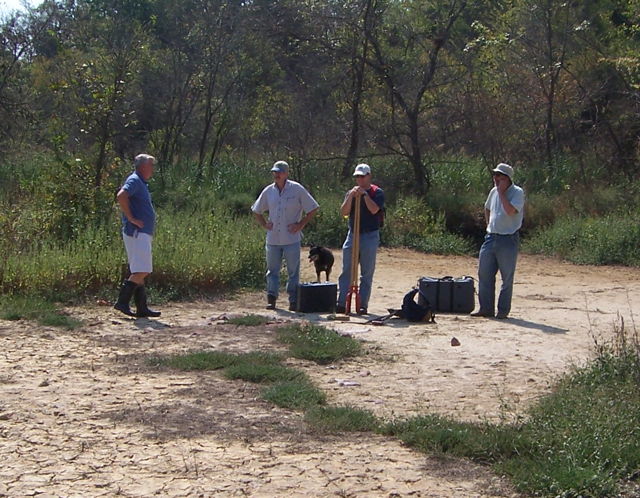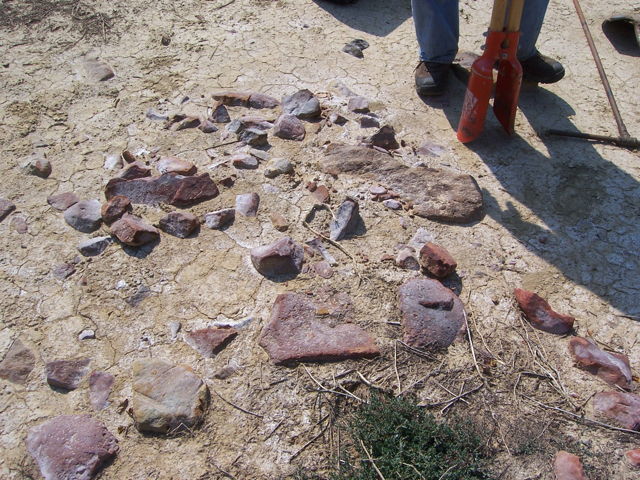
Friends of the Bullitt County History Museum
E-Newsletter
March 30, 2011 (Volume 7, Number 4)
Dear Friends,
Announcements...
>>Very Special Bullitt Genealogical Society Meeting Coming April 16. Ft. Knox Memorial Day Visitation Help. The only day of the year that a person can visit the old family and community cemeteries on the Ft. Knox military reserve is on Memorial Day. We often get questions about the hows and wheres and whens of that visitation day.
Well, if you might ever consider visiting those sites, you want to attend our Genealogical Society meeting in April. The Ft. Knox supervisor of that program will be our guest speaker. He will have maps, forms, and instructions on how and where to show up to visit the grave sites. As always, the society meeting will be held at the Ridgway Memorial Public Library located in Shepherdsville at North Walnut Street and Second Street. Meeting time is 10:00 a.m.
>>Genealogy Classes at Ridgway Library. Classes are in progress at our public library on genealogy. The next session, April 16, a little while after our Genealogical Society meeting, will "feature" (if you're willing to call it that) me, David Strange, talking about Bullitt County history and how local history pertains to genealogy research. Call the library at 502-543-7675, ext 5, to register, or e-mail Allison at programs@bcplib.org. You can also register online at the programs page of www.bcplib.org.
>>Family Fair August 20. Make plans now to attend the Bullitt County Genealogical Society Family Fair Day. Displays of family heirlooms, histories, photos, and other family memorabilia will be there and you can display items of yours as well. More on this in later newsletters, but plan for that date if you can, and come be with us! Reserve your free table before the limited space is filled. Deadline for table reservation is July 31.
Trivia Answer and Another Question.
Last month, I asked you: "Collings Hill Road, in southern Bullitt County, was once known by another name, and it can matter if you are searching for the location of something in that area. What was the earlier name of the road?"
Answer: Collings Hill Road was the original Bellmont (also spelled Bellmount) Road, running between Lebanon Junction and Bellmont. Bellmont was once a large, thriving community, with its own school, sports teams, and in the 1800's, an iron furnace that still exists today. So occasionally researchers will find mentions of things such as a Bellmont school along Collings Hill Road....and wonder why. Now you know why.
A trivia question for you this month is this: Henry Crist was a famous pioneer in Bullitt County. Among many other things, Henry was perhaps the only survivor of the "Battle of the Kettles" and he was a major player in the local salt industry. But I am told that "Henry" was not his first name. What was it?
Activity...
>>Another Great Genealogical Society meeting. 25 in attendance. The March meeting of the Bullitt County Genealogical Society was another good one. Renowned local genealogist Betty Darnell and County Clerk Kevin Mooney gave the group a tour of the research sources at the county clerk's office. Lot's of great stuff there for genealogists and historians alike!
>>Donation. In memory of Burlyn Pike, who passed away a few weeks ago, June Shane Stark Muir sent the museum a $500 donation and a kind note remembering Burlyn's days in Lebanon Junction.
>>Basket. Madonna Cash is widely known for the fine baskets she makes, including a "salt making basket" she made for one of our museum displays. But this time it's her husband Jimmy Cash doing the honors. Jimmy recently made a basket based on the colors of our county flag, and donated it to the museum. Thanks Jimmy! Friends, if you want to see more about our county flag, follow this link.
>>Web Site Additions.
Follow this link to the page of Latest Additions.
Bullitt's Lick Salt Test Results.
A Scientific Study.
>> Friends, because of the length of this special section, this is where I deviate from my normal newsletter format to give you details of what I think is an interesting report that I wrote a little about in the last newsletter. In the summer of 2010, Mr. Samuel V. Panno, Senior Geochemist with the University of Illinois, led a team to Bullitt County to test the salt waters of the famous Bullitt's Lick (for history of Bullitts Lick, follow this link). With Mr. Panno's permission, I here include much of the letter he sent me on December 28, 2010 on the results of that test. I view this information as important, not only for historical verification, but also for possible future uses such as road-salt brine and chef's cooking salts. The letter here is slightly modified for this newsletter and for clarification to you.
Dear Mr. Strange: Thank you for assisting us in sampling Bullitt's Lick this year. We greatly appreciate your help with our research. The trip to the site required passing through a dense, 10 foot-plus stand of fragmites, a halophilic (salt-loving) wetland plant. Mr. Clark (the landowner) was very accommodating and loaned us his tractor to bring our equipment and samples back to the main road. The site that Mr. Clark took us to was barren of vegetation and contained partially-buried rock piles with salt crystals on the rocks; Mr. Clark suggested that this was the site of the salt works. We hand-dug a four-foot deep well in the dry creek bed nearby because it was lower in elevation and had several thin puddles of saline water that wicked up from below. Upon hitting bedrock, groundwater and associated gases began entering the shallow well. A measurement of specific or electrical conductance in the field was near 40,000 micro-Siemens/cm indicating an extremely high dissolved mineral content. Normally, shallow and fresh groundwater in a region such as this would have a specific conductance of 500 micro-Siemens/cm. There was no doubt that the groundwater we sampled was saline and this site adds a very important piece of information for our investigation.


The work we are conducting involves mapping saline or slightly saline springs and wells throughout Illinois; we are using that information to map the distribution of concentrations of chloride in bedrock aquifers within the Illinois Basin (which includes a bit of Indiana and Kentucky). Chloride concentrations are typically very low in shallow aquifers and increases in concentration with depth; very deep groundwater is typically concentrated brine. Because chloride is a natural tracer, we can use its concentration to identify regional and local groundwater flow through the bedrock of the Illinois Basin. In addition to mapping chloride concentrations, we are examining the concentrations of bromide and iodide (present in very low concentrations) that can be used, in conjunction with chloride, to determine the depth from which the high-chloride groundwater is coming from. In addition, bromide and iodide can be used to differentiate the various sources of chloride (e.g., basin brines, road salt, sewage) from one another.
Below are the results of our analysis of your water from September 23, 2010. The water sample was filtered through a 0.45 micron high-capacity filter and preserved in the field and laboratory prior to analysis using standard techniques. All ions and dissolved organic carbon are reported in milligrams per liter.
| Parameters | Well/Spring |
|---|---|
| Temp. (in degrees C) | 22.0 |
| pH (in pH units) | 7.2 |
| Eh (in millivolts) | 67 |
| % Dissolved oxygen | 0.04 |
| Electrical conductance | 39,450 |
| Alkalinity (mg/liter) | 474 |
| Sodium | 7,284 |
| Potassium | 173 |
| Calcium | 1000 |
| Magnesium | 445 |
| Strontium | 99.6 |
| Barium | 176 |
| Boron | 3.46 |
| Silica | 11.5 |
| Bicarbonate | 578 |
| Sulfate | 0.63 |
| Chloride | 14,451 |
| Fluoride | <0.8 |
| Nitrate (as N) | <0.7 |
| Ammonium (as N) | 19.9 |
| Phosphate (as P) | 0.104 |
| Iron | 11.1 |
| Manganese | 0.49 |
| Dissolved organic carbon | 4.37 |
Bedrock in your area is made up of Mississippian-age limestone. The interaction of groundwater with carbonate rock (limestone) can create a calcium-magnesium bicarbonate type groundwater. However, mixing a shallow, fresh groundwater with highly saline groundwater from depth can create a sodium-chloride type groundwater at unusually shallow depths. The calcium and magnesium concentrations are somewhat high for groundwater in carbonate rock suggesting that the saline water came from a sodium-calcium-chloride brine, typical of deep basin brines in the Illinois Basin. The very low Eh and dissolved oxygen and the lack of sulfate and nitrate indicate that there is very little mixing of upwelling saline water with shallow, oxygenated ground water.
The water from Bullitt's Lick contains very high concentrations of sodium and chloride; in fact, this site contains some of the most saline spring water we have sampled in the Illinois Basin. Your estimate of 50 pounds (one bushel) (as suggested in old Bullitt County salt-making documents) of NaCl could be produced from 300 gallons of saline water (NaCl concentration of 22,000 mg/L) is essentially identical to what we find for the NaCl concentration of 21,735 mg/L of the saline groundwater we collected. Preliminary bromide concentrations suggest that the saline groundwater came from a very deep source within the Illinois Basin.
Again, thank you for your assistance.
Sincerely,
Samuel V. Panno
Senior Geochemist
Isotope Geochemistry Laboratory
Institute of Natural Resource Sustainability
University of Illinois
And thank you, Mr. Panno, for allowing us to reprint this portion of your study. Mr. Panno hopes to come back to Bullitt County to do more studies of other sites. His complete report is available at the Bullitt County History Museum research room.
Thank you, our valued reader, for being a Friend of the Bullitt County History Museum.
David Strange
Bullitt County History Museum
Executive Director
Museum Phone: 502-921-0161
E-Mail address: David.Strange@BullittCountyHistory.org
The Bullitt County History Museum, a service of the Bullitt County Genealogical Society, is located in the county courthouse at 300 South Buckman Street (Highway 61) in Shepherdsville, Kentucky. The museum, along with its research room, is open 10 a.m. to 4 p.m. Monday through Friday. Saturday appointments are available by calling 502-921-0161 during our regular weekday hours. Admission is free. The museum, as part of the Bullitt County Genealogical Society, is a 501(c)3 tax exempt organization and is classified as a 509(a)2 public charity. Contributions and bequests are deductible under section 2055, 2106, or 2522 of the Internal Revenue Code. Page last modified: 13 Sep 2024 . Page URL: bullittcountyhistory.org/newsletters/newsletter30mar11.html